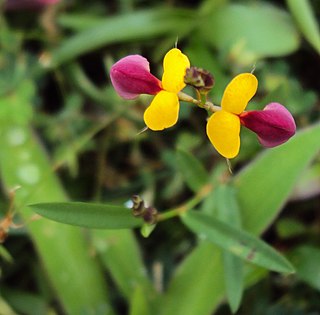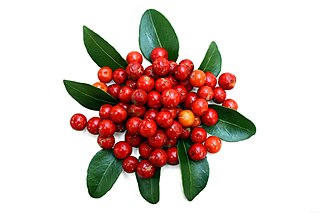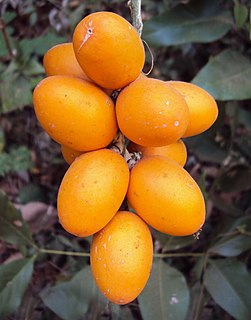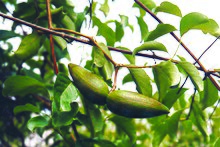
Crotalaria is a genus of flowering plants in the legume family Fabaceae commonly known as rattlepods. The genus includes about 500 species of herbaceous plants and shrubs. Africa is the continent with the majority of Crotalaria species, which are mainly found in damp grassland, especially in floodplains, depressions and along edges of swamps and rivers, but also in deciduous bush land, roadsides and fields. Some species of Crotalaria are grown as ornamentals. The common name rattlepod or rattlebox is derived from the fact that the seeds become loose in the pod as they mature, and rattle when the pod is shaken. The name derives from the Ancient Greek κρόταλον, meaning "castanet", and is the same root as the name for the rattlesnakes (Crotalus).

The plant tribe Phaseoleae is one of the subdivisions of the legume subfamily Faboideae, in the unranked NPAAA clade. This group includes many of the beans cultivated for human and animal food, most importantly from the genera Glycine, Phaseolus, and Vigna.

Alysicarpus is a genus of flowering plants in the legume family, Fabaceae. It is distributed in tropical and subtropical regions of Africa, Asia and Australia. Species are known generally as moneyworts. Unusually for legumes, the leaves are simple.

Millettia is a genus of legume in the family Fabaceae. It consists of about 150 species, which are distributed in the tropical and subtropical regions of the world. The genus was formerly known by the name Pongamia, but that name was rejected in favor of the name Millettia, and many species have been reclassified. Due to recent interest in biofuels, Pongamia is often the generic name used when referring to Millettia pinnata, a tree being explored for producing biodiesel.

Wendlandia is a genus of flowering plants in the family Rubiaceae. It is found in northeastern tropical Africa, and from tropical and subtropical Asia to Queensland.

Galactia is a genus of flowering plants in the legume family (Fabaceae). It belongs to the subfamily Faboideae. They do not have an unambiguous common name, being commonly called "milk peas", "beach peas" or "wild peas".

Pseudarthria is a genus of flowering plants in the legume family, Fabaceae. It belongs to the subfamily Faboideae, and contains some 6 species:

Bruguiera is a plant genus in the family Rhizophoraceae. It is a small genus of five mangrove species and three hybrids of the Indian and west Pacific Ocean region, its range extending from East Africa and Madagascar through coastal India, Sri Lanka and Southeast Asia to northern Australia, Melanesia and Polynesia. It is characterised by calyces with 8-16 lanceolate, pointed lobes, 16-32 stamens, explosive release of pollen, and viviparous propagules. It is named in honour of French explorer and biologist Jean Guillaume Bruguière (1750–1798). Recently, the eighth taxa of Bruguiera, B. × dungarra was recognised as occurring in northern Australia.

Cassine is a genus of trees, of the plant family Celastraceae.

Dendrophthoe is a genus of hemiparasitic shrubs found in Asia and Australia known as mistletoes. The genus was described by German naturalist Carl Friedrich Philipp von Martius in 1830. Species in this genus have a variety of reported uses in the medical traditions of the region, most notably in Nepal.

Ternstroemia gymnanthera is a species of flowering plant in the family Pentaphylacaceae which grows on elevations of 200–2,800 metres (660–9,190 ft) in Japan, China and on elevation of 1,200–1,500 metres (3,900–4,900 ft) in Himalayas. The plant is 3.5 metres (11 ft) tall and bloom from June to July.

Drypetes sepiaria is a species of small tree in the family Putranjivaceae. This tree is very common in India and Sri Lanka. It is known by many local names, including vellakasavu, veeramaram in Malayalam, vellilambu, veerai (வீரை), aadumilukkan, kaayalakkamaram in Tamil, and weera (වීර) in Sinhala.

Hemidesmus is a genus of plants in the Apocynaceae, first described in 1810. It is native to the Indian Subcontinent.
- Hemidesmus cordatus(Poir.) Schult. - India
- Hemidesmus indicus(L.) R. Br. ex Schult. - Pakistan, India, Bangladesh
- Hemidesmus indicus var. pubescensHook.f., syn of Finlaysonia wallichii(Wight) Venter
- Hemidesmus pubescensWight & Arn., syn of Finlaysonia wallichii(Wight) Venter
- Hemidesmus wallichiiWight, syn of Finlaysonia wallichii(Wight) Venter

Bruguiera parviflora is a tree in the family Rhizophoraceae. The specific epithet parviflora is from the Latin meaning "small flowers".

Spermacoceae is a tribe of flowering plants in the family Rubiaceae and contains about 1346 species in 57 genera. Its representatives are found in the tropics and subtropics.

Periplocoideae is a subfamily of the dogbane plant family, Apocynaceae. It was not divided into tribes as of 2014.

Heterostemma is a genus of plants in the family Apocynaceae, first described in 1834. It is native to India, China, Southeast Asia, Australia, and certain islands in the Pacific.

Decalepis arayalpathra is a species of plant in the family Apocynaceae. It is endemic to Peninsular India and known by its names of amirtha palaM in Tamil is a plant whose root is used in Ayurvedic medicines.

Mezoneuron is a genus of flowering plants in the legume family, Fabaceae. It belongs to the subfamily Caesalpinioideae and the tribe Caesalpinieae.

Sarcostigma is a genus of plants of the family Icacinaceae. It is originally from Malaysia. The genus was described by Robert Wight and George Arnott Walker Arnott and published in Edinburgh New Philosophical Journal in the year 1833.




















